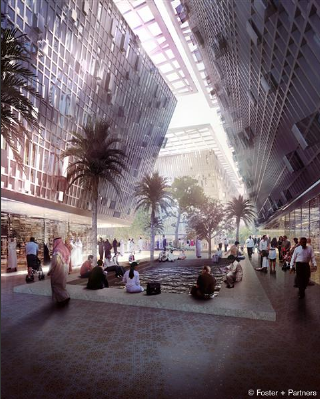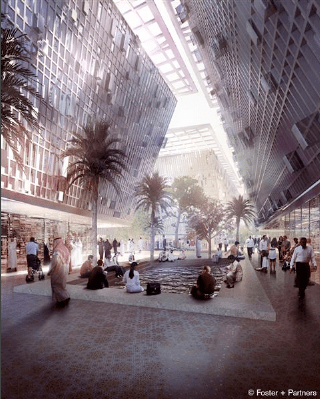 Does this look like a city to you?Illustration: Foster + PartnersThe “zero-carbon” city of Masdar, which is being built from scratch in Abu Dhabi in the United Arab Emirates, is ready for its first residents. This weekend, The New York Times architecture critic Nicolai Ouroussoff took a look at the first phase of this utopian project.
Does this look like a city to you?Illustration: Foster + PartnersThe “zero-carbon” city of Masdar, which is being built from scratch in Abu Dhabi in the United Arab Emirates, is ready for its first residents. This weekend, The New York Times architecture critic Nicolai Ouroussoff took a look at the first phase of this utopian project.
What he saw was a “sustainable city” that might, in fact, be sustainable. The question is whether it is actually a city.
Masdar seems at first glance like a dream come true for anyone who cares about the future of cities as proving grounds for innovative environmental technology.
It will be naturally cooled using “wind towers” that echo an ancient design. Ninety percent of its electricity will be solar-generated. Its streets will be free of cars — because underneath this paradise will be a network of electric, driverless vehicles.
Ouroussoff is duly impressed by all that bright green bling (which is paid for, of course, by the UAE’s oil money).
But he’s dismissive of Masdar’s prospects for becoming an authentic urban environment. In fact, he goes so far as to call the place “noxious.”
In Ouroussoff’s eyes, the shining city of Masdar — which was designed by Norman Foster of Foster + Partners — is the expression of an ugly trend:
[Foster’s] design…reflects the gated-community mentality that has been spreading like a cancer around the globe for decades. Its utopian purity, and its isolation from the life of the real city next door, are grounded in the belief — accepted by most people today, it seems — that the only way to create a truly harmonious community, green or otherwise, is to cut it off from the world at large….
[O]ne wonders, despite the technical brilliance and the sensitivity to local norms, how a project like Masdar can ever attain the richness and texture of a real city. Eventually, a light-rail system will connect it to Abu Dhabi, and street life will undoubtedly get livelier as the daytime population grows to a projected 90,000…
But the decision of who gets to live and work in Masdar, as in any large-scale development, will be outside the architect’s control. That will be decided by the landlord, in this case, the government.
And even if it were to become a perfect little urban melting pot, Masdar would have only limited relevance to the world most people live in. Mr. Foster’s inspired synthesis of ancient and new technologies could well have applications elsewhere; it should be looked at closely by other architects. But no one would argue that a city of a few million or more can be organized with such precision, and his fantasy world is only possible as a meticulously planned community, built from the ground up and of modest size.
What Masdar really represents, in fact, is the crystallization of another global phenomenon: the growing division of the world into refined, high-end enclaves and vast formless ghettos where issues like sustainability have little immediate relevance.
Masdar — which is laid out in a perfect square and surrounded by walls — has been criticized since its conception as mere window-dressing for a country where conspicuous consumption is a national sport.
Ouroussoff’s critique, however, hints at a much more troubling and important idea. The principles of New Urbanism have to a certain extent become ingrained in the planning lexicon of industrialized countries. But the dynamic and often messy energy that created the world’s greatest urban centers — Rome, London, New York, Tokyo — is sometimes seen as problematic by governments that want to market their municipalities to businesses, investors, and tourists.
Planners and architects in a place like Masdar can control a lot of things. Then there’s the X factor that makes a collection of buildings into a city worthy of the name. Can a place like Masdar find a way to let that inside the walls?




